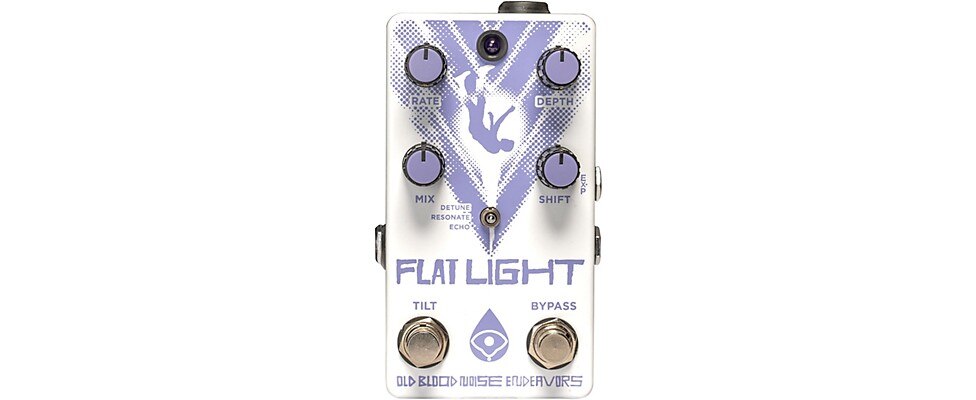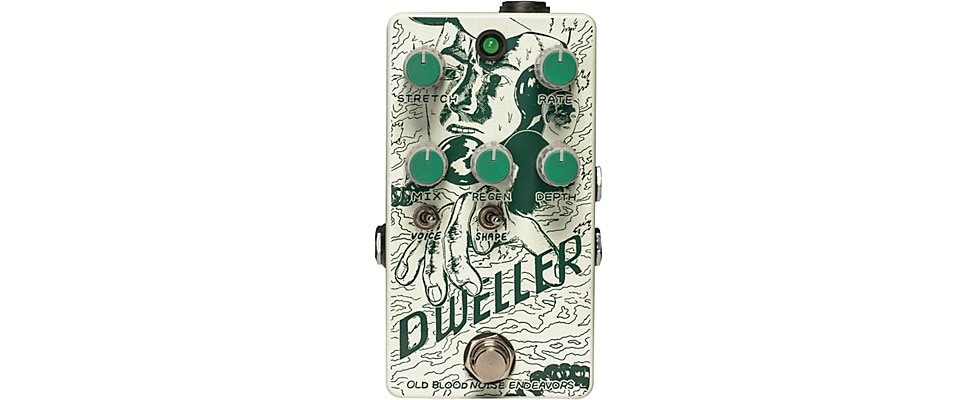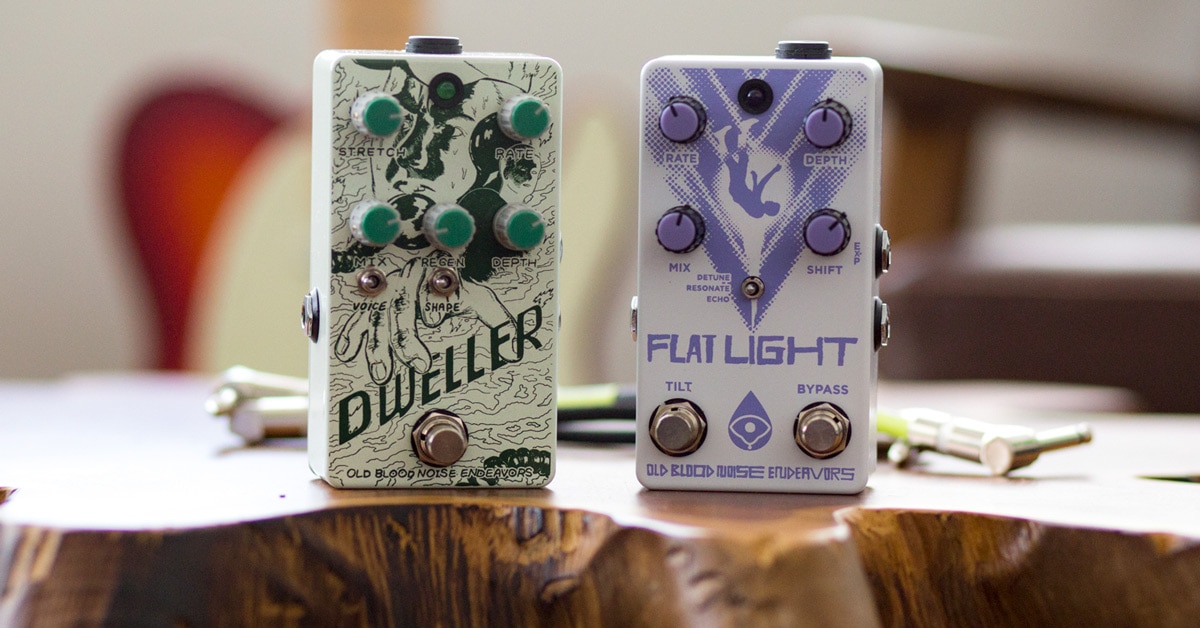Old Blood Noise Endeavors (henceforth OBNE) is a boutique pedal company based out of Oklahoma City, Oklahoma. They have been coming up with some of the more interesting items in the current crop of effects pedals. Musician’s Friend was kind enough to loan me eight of their pedals to check out, and you can find all of the reviews here on The Hub. This particular Hands-on Review deals with a pair of pedals that both do fascinating and quirky things with time and modulation—the Flat Light, which combines a flanger and a delay in some very interesting ways and the Dweller, which performs similar magic with a phase shifter and a delay.
Two types of time
Let’s start with the Flat Light. With both a flanger and a delay, we’re actually dealing with two types of time-based effects here, since a flanger simply applies a modulation wave to a very short—generally less than 20ms—delay. That familiar “whoosh” you hear is a moving comb filter created as the signal goes in and out of time phase as the delay time changes. The filter effects of a flanger are always harmonically related to what’s being played, which is one reason it’s such a musically useful tool.

Taking control of time
The controls of the Flat Light, like many of the OBNE pedals, can subtly change function in the pedal’s different modes. Here we have four knobs: Rate, Depth, Mix and Shift. In the middle of the pedal is a mini toggle that selects from three modes: Detune, Resonate and Echo. Finally, there are two footswitches: the self-explanatory Bypass and Tilt, a momentary switch which maxes out either Rate or Shift, depending on the setting of an internal switch.
So what do all these controls do? Generally speaking, Rate will set the speed/rate of modulation, Depth sets the amplitude of the modulation wave, Mix goes from full dry to full wet. That leaves the Shift knob, which is the one that varies from mode to mode. In Detune mode, Shift controls a pitch shift which feeds the flanger. This pitch shift is adjustable from an octave below to an octave above the input. The octave down setting can be heard in the audio sample “Flat Light Shift” below and more subtly in “Flat Light Detune.” Moving to Resonate mode, Shift controls the amount of feedback, which can take the pedal from a rich chorus at lower settings to a skronky, almost ring-modulator metallic resonance at higher settings, both of which are demonstrated in “Flat Light Resonate” and “Flat Light Skronk” below. Finally, in the Echo mode, multiple delay lines are added and Shift controls overall delay time. In this mode, the flanger has a fixed depth, and the Depth knob becomes a resonance control. This can be heard in the sonic chaos of the sample below which combines the Flat Light and Dweller pedals with the Excess distortion pedal, an effect I’ve reviewed in more depth for The Hub.
Getting in and out of phase with Dweller
Let’s move on to the Dweller pedal. Another one of OBNE’s twisted (in a totally awesome way) mashups of classic effects, Dweller combines a phase shifter with a delay line. That simple description comes nowhere near paying justice to what this pedal does, though. The synergy of the two effects expands this way beyond what you might have expected, or gotten, from just setting a delay pedal and phase shifter next to each other on your pedalboard. This isn’t to say that you can’t use it as a dedicated delay pedal (just turn Depth all the way down) or phaser (do the same with the knob labeled “Stretch”). Both are fine examples of their kind. It’s the cracks that get filled in when you get the two interacting in a single box that makes some serious magic.

Dweller’s knobs and switches
With five knobs, two switches and a connection for an expression pedal, there’s a lot of control available here. Three of the knobs will be familiar to anyone who’s used a phase shifter before—Depth, Rate and Mix. The knob labeled “Regen” controls the feedback of the circuit, i.e. the amount of the effected signal that’s fed back to be effected again. This makes the phaser effect more resonant and deeper, and adding repeats to the delay section. The “Stretch” knob controls how much memory is used for the effect. On the delay side, this simply makes for longer delays. On the phaser side, it’s a little harder to describe, but “stretch” is probably as close as you’ll get. The phasing develops an elastic quality, especially with the Voice switch in the 8-stage position.
This brings us to the switches. One, labeled “Voice,” switches between a 4 Stage and 8 Stage phase shifter. In phaser terminology, “stages” come in pairs, and each pair adds a notch filter (a narrow EQ band) that the phaser sweeps back and forth through. So, “4 Stage” means two notch filters and “8 Stage” means four filters, for a more complex sound. Unlike a flanger, which uses modulation of time to create sounds based on the natural harmonics of the program material, a phase shifter uses set points for its notch filters, and creates its effect from the sweep through a set of fixed resonant frequencies, so more notches creates a richer sound.
The second switch, “Shape,” selects which of three wave forms will be used to modulate the phasing effect. From left to right, you can choose a sine wave for a smooth, even sweep; a triangle wave for an even ramp with a sharp turnaround at the peak; or a pseudo-random step wave to add just a little unpredictability to your life.
Stretching the expression
Dweller’s Expression pedal input directly bypasses the Stretch knob and puts it under the control of any TRS-connected expression pedal. This is a feature well worth playing with, as the interaction between the phaser and delay in the pedal can change fairly radically as you sweep through this control. Remember that “Stretch” is setting how much memory is available, which mean longer delays and more rubbery (for lack of a better term) phasing. This type of interaction is unique to Dweller, and where some of its most inspiring sounds are found.
Dweller in use
As I put this pedal through its paces, I tended to stay away from the purely delay or purely phase ranges, as those can be found in many other pedals. The charm of Dweller is that interaction between the two, and in getting tuned into how they can push and pull against each other. In the example “Dweller Echo” below, a fairly high feedback setting creates a warped surf guitar sound and, with judicious volume swells, an organ-like effect. The sample “Dweller Sine Wave Echo” uses a longer repeat and a higher phaser depth to add a little wash to a classic cascading echo line. Finally, the sample “Dweller Step Wave” uses the pseudo-random wave sweep at a higher sweep rate to create a sort of vaguely seasick ostinato figure. I especially love the way this waveform choice can keep the sound slightly off balance.
Putting it all together
One thing that OBNE has certainly mastered is finding the possibilities of combining more-or-less conventional effects in new ways in a single pedal, then providing the player with a set of controls that provide satisfying results without a long learning curve. With all their pedals I’ve had the chance to work with, they’ve been musically surprising and inspiring in more or less equal proportions. These two are certainly no exception to that. They both inspired me to dig deeper into my musical bag of tricks as they led me to new sounds and possibilities. If musical exploration is your thing and you love to spend hours discovering interesting sonic wormholes to run your gear through, you’d be hard pressed to do better.







































































































































